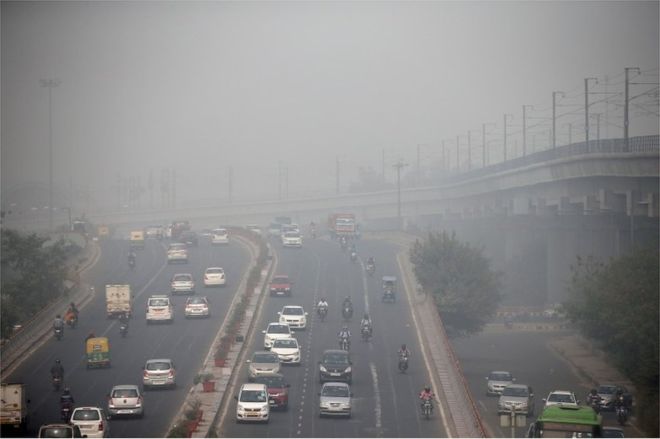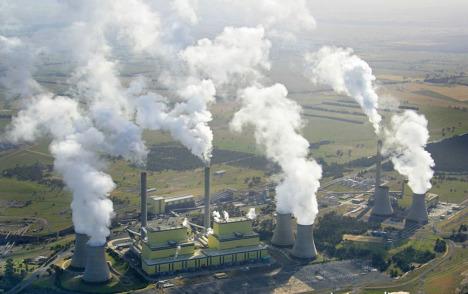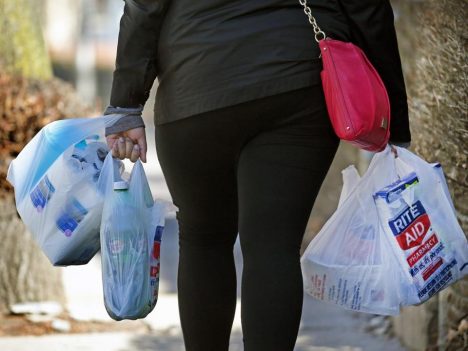Climate Change
- 20 Jun, 23
- by Admin
- in Climate Change
-
 0
0
-

 0
0
Nigeria’s Bank of Industry has signed a deal valued at $100 million with the French Development Agency for the expansion of green finance in Nigeria to tackle climate change.
The deal was signed by Managing Director, BoI, Mr Olukayode Pitan and Mr Xavier Muron, Country Director, AfD in Lagos, according to the News Agency of Nigeria. He stated the transaction was approved by AfD under its Transforming Financial Systems for Climate (TFSC) Programme with the Green Climate Fund (GCF).
More details at:
https://nairametrics.com/2022/08/24/bank-of-industry-signs-100-million-agreement-with-france-to-combat-climate-change-in-nigeria/
- 06 Jun, 23
- by Admin
- in Climate Change
-
 0
0
-

 0
0
Like every other country, Nigeria’s waste collectors with support from organisations like Nestle are providing solutions by picking them and also making a living from them. These wastes include packaging materials like water sachets and plastic bottles among others.
According to a 2018 report by the United Nations, 11.2 billion tons of solid waste is collected every year, contributing to about per cent of global greenhouse emissions.
The World Bank, also in 2018, reported that without swift action, global waste will rise by 7 per cent on current levels by 2050.
With these scary figures, countries including Nigeria are working towards tackling the challenge by reducing, reusing and recycling them, making waste generation and management as sustainable as possible.
In Nigeria, the Food and Beverage Recycling Alliance, FBRA, are partnering with the Lagos State Waste Management Authority (LAWMA) and the Lagos State Recyclers Association (LAGRA) to tackle the problem.
The Alliance, with a current membership of 28 organisations, was established in 2018 as the industry-coalition Producer Responsibility Organisation (PRO) for enhancing the collection and recovery of post-consumer packaging material in the Food and Beverage sector.
Within the last four years, the Alliance in partnership with stakeholders in the waste value chain in Lagos state has impacted over 50 communities to educate and create awareness on recycling, facilitated the training of 3,000 waste pickers and has supported the collection of over 25,000 metric tonnes of recyclables for recovery to productive use through a partnership with over 12 packaging waste aggregators.
FBRA has also partnered with several NGOs to educate children in schools on the need for responsible disposal including recycling and has provided 75 recycling collection giant bins in schools, public spaces, and communities.
The focus is for Alliance member companies to contribute funds to support the waste management operations of the waste ecosystem through the implementation of Extended Producer Responsibility (EPR) in the packaging sector.
Speaking at the third anniversary of the Lagos Recycling Initiative, the Executive Secretary of the Alliance, Onaghise Agharese emphasised the importance of source segregation atthe point of generation within homes and organisations to enhance the quality of the recyclables harvested.
She also emphasised the need for collaborative efforts of all relevant stakeholders to implement an effective waste management system whilst pledging the commitment of the Alliance member companies to support more projects.
The MD of LAWMA, Ibrahim Odumboni also called on Food and Beverage organisations to join the efforts of the Alliance and informed all that the Agency is set to implement the Adopt the Bin Initiative where all households are expected to use the blue recycling bins to sort their waste, call for pick-up through PAKAM app and a LAGRA member in their vicinity will pick up their recyclables for an incentive. Dr. Femi Idowu Adegoke, the Chairman of the Lagos Recyclers Association (LAGRA) encouraged all to join the ZerWastete campaign through continuous public education, attitudinal and behavioural change towards minimizing (reducing), reusing, recovering, repurposing (upcycling and downcycling) and recycling for an efficient and sustainable circular economy in Lagos.
He also provided a commitment that its members under Lagos Recyclers Association LAGRA are available toff-take recyclables for all households who have to segregate their waste and books for collection through the PAKAM App.
PAKAM App is a technology application that can be downloaded from the m play store that connects households to collectors nearest to them to enable them to trade in their separated waste for incentives or cash. FBRA hereby encourages residents of Lagos state to adopt waste separation from source and recycling thereby earning rewards and incentives from recycling through the PAKAM App for a cleaner Lagos and a better planet for us all.
SOURCE: Vanguard News
- 20 Mar, 20
- by Admin
- in Climate Change, Uncategorized
-
 0
0
-

 0
0
We’re all too aware of the consequences of plastics in the oceans and on land. However, beyond the visible pollution of our once pristine habitats, plastics are having a grave impact on the climate too.
Newly published research calculates that across their lifecycle, plastics account for 3.8% of global greenhouse gas emissions. That’s almost double the emissions of the aviation sector. If it were a country, the “Plastic Kingdom” would be the fifth-highest emitter in the world.
Demand is set to rise, too. At 380m tonnes a year, we produce 190 times more plastic than we did in 1950. If the demand for plastic continues to grow at its current rate of 4% a year, emissions from plastic production will reach 15% of global emissions by 2050.
Plastic across the lifecycle
More than 99% of plastics are manufactured from petrochemicals, most commonly from petroleum and natural gas. These raw materials are refined to form ethylene, propylene, butene, and other basic plastic building blocks, before being transported to manufacturers.
The production and transport of these resins requires an awful lot of energy – and therefore fuel. Greenhouse gas emissions also occur during the refining process itself – the “cracking” of larger hydrocarbons from petrochemicals into smaller ones suitable for making plastic releases carbon dioxide and methane. According to the study, about 61% of total plastic greenhouse gas emissions comes from the resin production and transport stage.
A further 30% is emitted at the product manufacturing stage. The vast majority of these emissions come from the energy required to power the plants that turn raw plastic materials into the bottles, bin bags and bicycle helmets we use today. The remainder occurs as a result of chemical and manufacturing processes – for example, the production of plastic foams uses HFCs, particularly potent greenhouse gases.

Ignition of trapped methane pockets in landfills can set off massive fires, releasing the carbon stored in plastic.
The remaining carbon footprint occurs when plastics are thrown away. Incineration releases all of the stored carbon in the plastic into the atmosphere, as well as air pollutants such as dioxins, furans, mercury and polychlorinated biphenyls, which are toxic and damaging to human health.
As plastics take centuries to degrade, disposal in landfill makes only a small contribution to emissions in theory. However, as much as 40% of landfill waste is burnt in open skies, dramatically speeding up the release of otherwise locked-up carbon.
Making plastic climate-friendly
If we are to combat climate breakdown, reductions in plastic emissions are clearly needed. Thankfully, the solution with the biggest potential is already in motion, albeit snow. In showing that transitioning to a zero carbon energy system has the potential to reduce emissions from plastic by 51%, the study provides yet another reason to rapidly phase out fossil fuels.
However, beyond urgently required global decarbonisation, we need to reduce our seemingly insatiable demand for carbon-based plastic. Increasing recycling rates is one simple way of doing this. The highest-quality plastics can be recycled many times, and nearly all plastic can be recycled to some extent – but only 18% was actually recycled worldwide in 2015. Although each recycle process requires a small amount of new plastics, we can greatly increase the life cycle of the material by efficiently reusing what we make.
A more fundamental solution is to switch to making plastics from biodegradable sources such as wood, corn starch, and sugar cane. The materials themselves are carbon neutral, although renewable power is essential to eliminate the climate impact of energy costs during production, transport and waste processing.
However, a massive ramping up in the production of bioplastics – which currently make up less than 1% of total plastic production – would require vast swathes of agricultural land. With the population set to arise dramatically, increasingly coveted arable space may not be able to satisfy demand.

The bottom line, therefore, is that we will need to reduce our demand for plastic. According to the study, simply reducing the annual growth in plastics demand from 4% to 2% could result in 60% lower emissions from the sector in 2050. While a life without plastics may seem unimaginable, its worth remembering that their prevalence is a relativity recent phenomenon. The first artificial plastic, Bakelite, was developed in 1907, but it wasn’t until the 1950s that the age of plastic began. If we show a genuine appetite to address plastic pollution, the world could change again just as quickly.
Governments, corporations, and individuals must make research into alternatives a priority, and support alternatives to needless plastic waste. Were most people to carry a reusable water bottle, for example, we could eliminate the need for the estimated 20,000 single-use bottles bought each second around the world.
Of course, any of these solutions alone will not be enough. As the recent study notes, only by combining reduction in demand, top-notch recycling, decarbonisation of energy, and large-scale adoption of bioplastics can we tackle plastic’s contribution to the climate crisis. But if we manage to do all of this, then we can cut plastics emissions to just 7% of current levels.
Plastics need not be completely demonised as environmental scourges. Affordable, durable, and versatile, they bring a raft of societal beefits, and will undoubtedly serve an important role where replacements are unable to be found. But decades of unbridled use and a throw-away culture are having grave consequences that go far beyond the visible pollution of our land and water. It is essential that we drastically reduce our use of avoidable plastics, and eliminate the carbon footprint of the ones we need to use. Our relationship with plastic may be toxic, but it doesn’t need to be forever.
- 05 Dec, 18
- by Admin
- in BYOB Campaign, Climate Change, Ocean Conservation, Youth Awareness
-
 0
0
-

 0
0
Plastics have much to offer as a modern convenience, but lack of responsible plastic waste management habits can lead to potentially harmful environmental effects. Past environmental initiatives revealed a lack of understanding about youth attitudes towards pro‐environmental issues. Plastic, an online public environmental promotional campaign, encouraged youth to recognize the importance of, adopt positive attitudes towards and subsequently adopt the practice of responsible plastic management. We propose the Temporal Incentives Model of Social Influence to guide social campaign design. A pre‐post quantitative research design showed that the pre‐contemplation, contemplation and preparation stages progressed significantly after the campaign. The findings suggest that stimuli incorporating specialized information and small action steps allow migration to successive stages. With the strong presence of internet culture among youth, the online medium was found effective in altering the attitudes of the campaign target audience, while exposure to the campaign messages proved useful in encouraging environmental learning among youth.
- 30 May, 17
- by Admin
- in Climate Change
-
 0
0
-

 0
0
People who deny that humans are wreaking havoc on the planet’s life-support systems astound me. When confronted with the obvious damage we’re doing to the biosphere—from climate change to water and air pollution to swirling plastic patches in the oceans—some dismiss the reality or employ logical fallacies to discredit the messengers. More…
- 17 Mar, 17
- by Admin
- in Climate Change, Disposable Bag Reduction
-
 0
0
-

 0
0
Plastic Bags and climate change are linked in a variety of ways. From air quality to ocean toxicity, plastic bags contribute to eco-system disruption.
Habitat destruction, fossil fuel emissions, and plastic pollution are some of the ways that plastic bags and climate change cannot be separated. More…
- 21 Dec, 16
- by Admin
- in Climate Change
-
 0
0
-

 0
0
 Delhi in India is one of the most polluted cities in the world. The widespread use of festival fireworks, the burning of rubbish by the city’s poor, plus farm waste from around the city, vehicular emissions and construction dust, all contribute to the city’s thick fogs.
Delhi in India is one of the most polluted cities in the world. The widespread use of festival fireworks, the burning of rubbish by the city’s poor, plus farm waste from around the city, vehicular emissions and construction dust, all contribute to the city’s thick fogs.
A team of researchers from the US, India and Singapore will be attempting some time next year to clean up the air around a coal-fired plant in Delhi. More…
- 03 Sep, 16
- by Admin
- in Climate Change
-
 0
0
-

 0
0
China and the US have formally ratified a historic climate change agreement drawn up in Paris to cut emissions and fight climate change. Speaking on the eve of the G20 summit in Hangzhou on Saturday, Mr Obama said: “History will judge today’s effort as pivotal.” The US and China are together responsible for 40% of the world’s carbon emissions. More…
- 16 Aug, 16
- by Admin
- in Climate Change
-
 0
0
-

 0
0
Do you know that having plants around your home can help remove airborne contaminants like VOCs (volatile organic compounds), as well as reduce the chances of headaches, common cold, high blood pressure and allergies.
Here’s a list of plants with proven air quality improvement properties. More…









